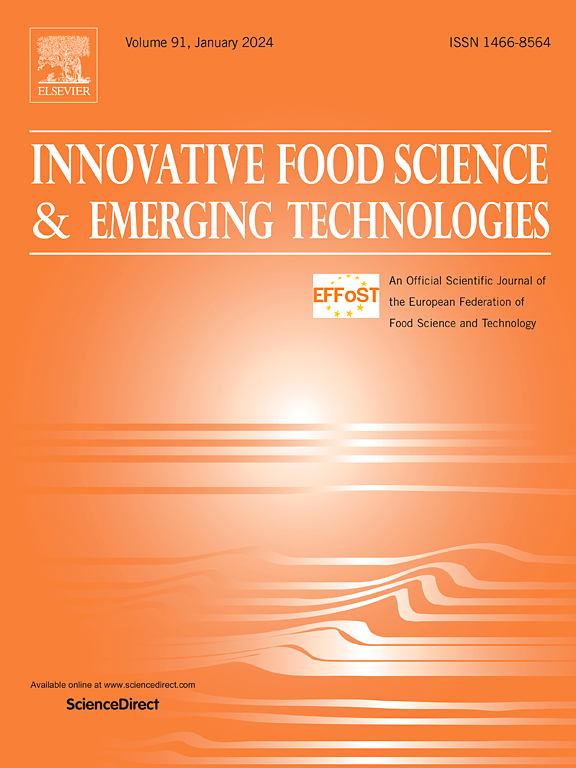Hollow solid lipid particles loaded with essential oils via supercritical carbon dioxide to develop novel antimicrobial lipids with controlled release for food applications
IF 6.3
1区 农林科学
Q1 FOOD SCIENCE & TECHNOLOGY
Innovative Food Science & Emerging Technologies
Pub Date : 2025-03-04
DOI:10.1016/j.ifset.2025.103980
引用次数: 0
Abstract
The main objective of this study was to develop essential oil-loaded hollow lipid particles with a solid shell as natural food antimicrobials. Peppermint essential oil-loaded hollow solid lipid micro- and nanoparticles were successfully formed by atomization of the CO2-expanded lipid mixture. Essential oil-loading efficiency ranged from 47.5 to 52.7 % depending on the lipid matrix. Particles generated with fully hydrogenated soybean oil (FHSO) and its blends with liquid oils were all spherical but with wrinkles on the surface. The release of the loaded essential oil was altered by changing the lipid matrix. Particles obtained with FHSO as the lipid shell exhibited a faster release (up to 24 %) of the loaded essential oil than those obtained with blends of FHSO and canola oil/sesame oil/camelina oil, which was attributed to the variation in physical strength of the solid lipid shell and extent of particle agglomeration. Moreover, essential oil-loaded FHSO particles achieved >5.5 log reduction on Bacillus cereus and Lactococcus lactis in UHT fat-free milk at 22 °C storage.

空心固体脂质颗粒装载精油通过超临界二氧化碳开发具有控释的新型抗菌脂质用于食品应用
本研究的主要目的是开发具有固体外壳的含有精油的中空脂质颗粒作为天然食品抗菌剂。通过雾化二氧化碳膨胀的脂质混合物,成功地形成了薄荷精油负载的空心固体脂质微颗粒和纳米颗粒。精油负载效率范围从47.5%到52.7%取决于脂质基质。用完全氢化大豆油及其与液体油的混合物生成的颗粒都是球形的,但表面有褶皱。通过改变脂质基质来改变负载精油的释放。用FHSO作为脂质壳得到的颗粒比用FHSO和菜籽油/芝麻油/亚麻荠籽油混合得到的颗粒释放速度更快(高达24%),这是由于固体脂质壳的物理强度和颗粒团聚程度的变化。此外,精油负载的FHSO颗粒在22°C储存的UHT脱脂牛奶中对蜡样芽孢杆菌和乳酸乳球菌的作用降低了5.5 log。
本文章由计算机程序翻译,如有差异,请以英文原文为准。
求助全文
约1分钟内获得全文
求助全文
来源期刊
CiteScore
12.00
自引率
6.10%
发文量
259
审稿时长
25 days
期刊介绍:
Innovative Food Science and Emerging Technologies (IFSET) aims to provide the highest quality original contributions and few, mainly upon invitation, reviews on and highly innovative developments in food science and emerging food process technologies. The significance of the results either for the science community or for industrial R&D groups must be specified. Papers submitted must be of highest scientific quality and only those advancing current scientific knowledge and understanding or with technical relevance will be considered.

 求助内容:
求助内容: 应助结果提醒方式:
应助结果提醒方式:


